

Indian Country Today. Culture of India. The culture of India refers to the way of life of the people of India.
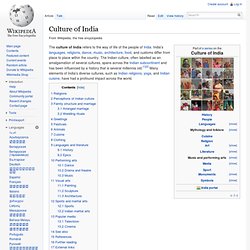
India's languages, religions, dance, music, architecture, food, and customs differ from place to place within the country. The Indian culture, often labelled as an amalgamation of several cultures, spans across the Indian subcontinent and has been influenced by a history that is several millennia old.[1][2] Many elements of India's diverse cultures, such as Indian religions, yoga, and Indian cuisine, have had a profound impact across the world. Religions[edit] India is the birthplace of Hinduism, Buddhism, Jainism and Sikhism, collectively known as Indian religions.[4] Indian religions, also known as Dharmic religions are a major form of world religions along with Abrahamic one.
Today, Hinduism and Buddhism are the world's third and fourth-largest religions respectively, with over 2 billion followers altogether,[5][6][7] and possibly as many as 2.5 or 2.6 billion followers.[5][8] History of India: Modern era. File:British Indian Empire 1909 Imperial Gazetteer of India.jpg. Outline of India. An enlargeable map of the cities of India The following outline is provided as an overview of and topical guide to India: India – seventh-largest country by area, located on the Indian subcontinent in South Asia.

India was home to the ancient Indus Valley Civilisation, and is the birthplace of four world religions—Hinduism, Sikhism, Buddhism, Jainism, India endured colonization, eventually being administered by the United Kingdom from the mid-19th century to the mid-20th century. India became an independent nation in 1947 after a struggle for independence that was mainly non-violent resistance, led by influential figures like Mahatma Gandhi.
India is the second-most populous country with over 1.2 billion people, and is also the most populous democracy in the world. General reference[edit] History of India: Early modern era. History of India: Medieval. History of India: Ancient. History of India. The history of India begins with evidence of human activity of Homo sapiens, as long as 75,000 years ago, or with earlier hominids including Homo erectus from about 500,000 years ago.[1] The Indus Valley Civilization, which spread and flourished in the northwestern part of the Indian subcontinent from c. 3300 to 1300 BCE in present-day Pakistan and northwest India, was the first major civilization in South Asia.[2] A sophisticated and technologically advanced urban culture developed in the Mature Harappan period, from 2600 to 1900 BCE.[3] This civilization collapsed at the start of the second millennium BCE and was later followed by the Iron Age Vedic Civilization, which extended over much of the Indo-Gangetic plain and which witness the rise of major polities known as the Mahajanapadas.
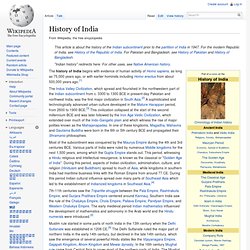
In one of these kingdoms, Magadha, Mahavira and Gautama Buddha were born in the 6th or 5th century BCE and propagated their Shramanic philosophies. Prehistoric era[edit] Stone Age[edit] Bronze Age[edit] Etymology of India. History of the Republic of India. The history of the Republic of India began on 26 January 1950.
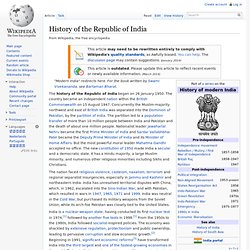
The country became an independent nation within the British Commonwealth on 15 August 1947. Names of India. The name India may refer to either the region of Greater India (the Indian subcontinent) or to the contemporary Republic of India located therein.
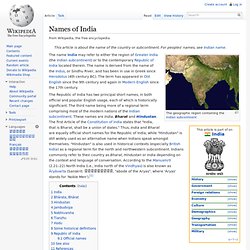
The name is derived from the name of the Indus, or Sindhu River, and has been in use in Greek since Herodotus (4th century BC). The term has appeared in Old English since the 9th century and again in Modern English since the 17th century. The Republic of India has two principal short names, in both official and popular English usage, each of which is historically significant. The third name being more of a regional term comprising most of the modern nations of the Indian subcontinent. These names are India, Bharat and Hindustan. Foreign relations of India. India is a newly industrialised country, it has a long history of collaboration with several countries and is considered one of the leaders of the developing world along with China, Brazil, Russia and South Africa (the BRICS countries).[5][6] India was one of the founding members of several international organisations, most notably the United Nations, the Asian Development Bank, G20 industrial nations and the founder of the Non-aligned movement.

India has also played an important and influential role in other international organisations like East Asia Summit,[7] World Trade Organisation,[8] International Monetary Fund (IMF),[9] G8+5[10] and IBSA Dialogue Forum.[11] Regionally, India is a part of SAARC and BIMSTEC. India has taken part in several UN peacekeeping missions and in 2007, it was the second-largest troop contributor to the United Nations.[12] India is currently seeking a permanent seat in the UN Security Council, along with the G4 nations.[13] History[edit] Policy[edit] Political divisions in India. Administrative divisions of India. The Administrative divisions of India are Indian subnational administrative units; they compose a nested hierarchy of country subdivisions.

Indian states and territories frequently use different local titles for the same level of subdivision (e.g., the mandals of Andhra Pradesh correspond to tehsils of Uttar Pradesh and other Hindi-speaking states and talukas of Gujarat, Goa, Karnataka, Kerala and Tamil Nadu).[1] In the context of the Indian Constitution, local government bodies are the subject of the State List and are thereby governed by State Statutes, or in the case of Union Territories, by the Union Parliament. Federal recognition of local government was substantively expressed in the 74th Constitution Amendment Act of 1992. Zones[edit] The States have been grouped into six zones having an Advisory Council 'to develop the habit of cooperative working” among these States.
States and union territories[edit] States Union territories See also: Regions[edit] Divisions[edit] Districts[edit] Elections in India. India has an asymmetric federal government, with elected officials at the federal, state and local levels.
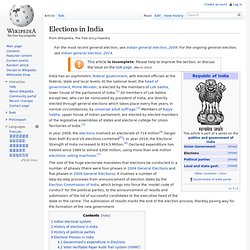
Government of India. The Government of India (GoI), officially known as the Union Government, and also known as the Central Government, was established by the Constitution of India, and is the governing authority of the union of 29 states and seven union territories, collectively called the Republic of India.
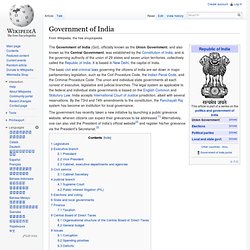
It is based in New Delhi, the capital of India. The government has recently taken a new initiative by launching a public grievance website, wherein citizens can expect their grievances to be addressed.[1] Alternatively, one can also visit the President of India's official website[2] and register his/her grievance via the President's Secretariat.[3] Legislature[edit] Political integration of India. British India and the princely states in 1909 The divisions of India as set out in the Constitution of 1950 At the time of Indian independence in 1947, India was divided into two sets of territories, the first being the territories under the control of the British Empire, and the second being the territories over which the Crown had suzerainty, but which were under the control of their hereditary rulers.

In addition, there were several colonial enclaves controlled by France and Portugal. Politics of India. Politics in India. Politics in India (Hindi:भारतीय राजनीति) takes place within the framework of a constitution. Geography of India. This video was taken by the crew of Expedition 29 on board the ISS on a pass from western Europe to Central India. The geography of India describes the geographic features of India, a country in South Asia. India lies largely on the Indian Plate, the northern portion of the Indo-Australian Plate, whose continental crust forms the Indian subcontinent.
The country is situated north of the equator between 8°4' and 37°6' north latitude and 68°7' and 97°25' east longitude.[2] It is the seventh-largest country in the world, with a total area of 3,166,414 square kilometres (1,222,559 sq mi).[3] India measures 3,214 km (1,997 mi) from north to south and 2,933 km (1,822 mi) from east to west. It has a land frontier of 15,200 km (9,445 mi) and a coastline of 7,517 km (4,671 mi).[4] File:India topo big.jpg. Geology of India. Firstly, the Deccan Trap covers almost all of Maharashtra, a part of Gujarat, Karnataka, Madhya Pradesh and Andhra Pradesh marginally.
It is believed that the Deccan Trap was formed as result of sub-aerial volcanic activity associated with the continental deviation in this part of the Earth during the Mesozoic Era. That is why the rocks found in this region are generally igneous type. The Gondwana and Vindhyan include within its fold parts of Madhya Pradesh, Chhattisgarh, Odisha, Bihar, Jharkhand, West Bengal, Andhra Pradesh, Maharashtra, Jammu and Kashmir, Punjab, Himachal Pradesh, Rajasthan and Uttarakhand. The Gondwana Supergroup forms a unique sequence of fluviatile rocks deposited in Permo-Carboniferous time. Damodar and Sone river valley and Rajmahal hills in the eastern India are depository of the Gondwana rocks. Plate tectonics[edit] Geography of India. Sports in India. Indian cuisine. India cuisine or Indian food encompasses a wide variety of regional cuisines native to India.
Given the range of diversity in soil type, climate and occupations, these cuisines vary significantly from each other and use locally available spices, herbs, vegetables and fruits. Indian food is also heavily influenced by religious and cultural choices and traditions. The development of these cuisines have been shaped by Dharmic beliefs, and in particular by vegetarianism, which is a growing dietary trend in Indian society.[1] There has also been Central Asian influence on North Indian cuisine from the years of Mughal rule.[2] Indian cuisine has been and is still evolving, as a result of the nation's cultural interactions with other societies.[3][4] Historical incidents such as foreign invasions, trade relations and colonialism have also played a role in introducing certain foods to the country.
History[edit] Antiquity[edit] Middle Ages[edit] Ingredients[edit] Spices at a grocery shop in India. Cuisine in India. Clothing in India. Clothing in India varies from region to region depending on the ethnicity, geography, climate and cultural traditions of the people of that region. Historically, men and women clothing has evolved from simple Langotas, and loincloths to cover the body to elaborate costumes not only used in daily wear but also on festive occasions as well as rituals and dance performances. In urban areas, western clothing is common and uniformly worn by people of all strata. India also has a great diversity in terms of weaves, fibers, colours and material of clothing. Colour codes are followed in clothing based on the religion and ritual concerned.
For instance, Hindu ladies wear white clothes to indicate mourning, while Parsis and Christians wear white to weddings. Clothing in India. Society in India. Movies and Television of India. Performing arts of India. Literature of India. Art and Architecture of India. Culture of India.